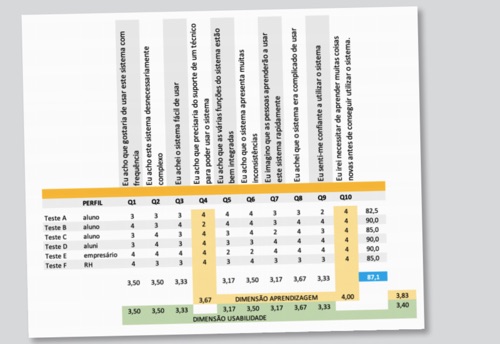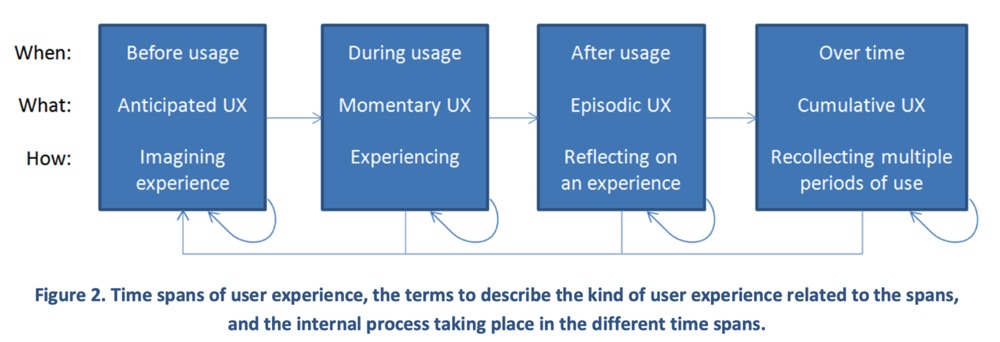Menu


Managing Partner YouX

Managing Partner iBloom
In the article What is User eXperience (UX) and how it differs from Usability we talk about the concepts of UX and Usability. In this article we will identify some dimensions that we must take into account to evaluate UX and Usability.
The importance of UX varies depending on the product and its intended use.
The techniques to be used depend on the time horizon in which you want to work. The concept of user experience by Roto, V., Law, E. Vermeeren, A. & Hoonhout, J. (2011) adds a temporal component to UX that will translate into the use of different evaluation methodologies.
Although the authors emphasize that the core of the user experience is the experience of use, they consider that the user experience can even be prior to the first use, indirectly, based on expectations or experience of using related systems (anticipated UX ); may refer to a change in feelings during interaction with the system (momentary UX); It can refer to the evaluation of a specific episode (episodic UX) or to views of the system as a whole after using a system for some time (cumulative UX).

When we work with a UX process, it is important to define the period of time that will be considered: momentary, episodic or cumulative UX. If we consider shorter periods we can provide information such as people's reactions to the user interface. Opting for longer periods can reveal the impact of momentary experiences on cumulative UX.
When we define longer UX periods, we can structure the user experience in terms of life cycles or user journey, ranging from the first encounter with the system, episodes of use and even reflection on use. Previous experiences influence future experiences, which allows us to shape future anticipations.
According to ISO 9241-11, usability assessment should take into account:
Due to the strong influence of context, it is very difficult to compare the usability of different systems, only subjective evaluations allow inter-system comparison.
Some methods for measuring usability are: System Usability Scale (SUS), Microsoft Card Method, Contextual Interview, Think and Speak Aloud, First Click Testing , Card Sorting .
Roher (2014) looked specifically at research methods for UX, referring to the wide variety of methods available, from tried and tested ones to new forms of online assessment.
Highlighting the importance of knowing how to select the methods to be used in a given project (the number of which is normally limited), it presents a Framework with 20 methods 5 organized according to three axes to help select the methods to be used in a given project:
Attitudinal dimension vs. behavioral: what people say versus what people do.
This is, moreover, a dichotomy that runs throughout the areas of social studies and opinion studies and that should keep us alert whenever we use surveys and interviews. The author considers that most usability studies should be based more on the behavioral aspect (e.g. A/B testing, eyetracking ), but the attitudinal aspect can also be important, particularly for mapping users' mental models and developing information architectures.
Qualitative Dimension vs. Quantitative : qualitative studies (e.g. observation) as a generator of data collected directly versus data from quantitative studies obtained indirectly.
In usability studies, direct observation has the advantage of the researcher being able to see how the user uses the technology and immediately ask questions, investigate or correct some aspect of the study. Qualitative methods tend to be more suitable for answering questions about why a certain behavior or action is taking place, or how to correct a problem. Qualitative methods are much more suitable for dealing with large amounts of questions and information.
As the first two dimensions determine the type of questions that can be asked:
The context of product use : are study participants using the product or service and how. What can be demultiplied:
Roher (2014) also considers that the product development phases, which he calls the time dimension, are also important when selecting research methods:
The available methods are not limited to the 20 proposed by Roher. Other authors suggest approaches that seem particularly interesting to us, such as: Prototyping, Personas and User Journey (also known as Journey Mapping).
In another post we will analyze these methods in detail.
YouX is a software development company focused on providing the best user experiences.
Sede: Av. da Peregrinação, 9, 1 dto – 1990-425 Lisboa
Info@you-x.eu – Telefone: +351 211 353 284
Digital Strategy
UX Design
UI Design
Digital Sprints
User Research
AR applications
WebAR
UX Audits
Software development
Mobile Applications
Web Apps
© 2021-25 Xperialab Lda ® Todos os direitos reservados.
YouX is a software development company focused on providing the best user experiences.
Digital Strategy
UX Design
UI Design
Digital Sprints
User Research
AR applications
Web AR
Software development
Mobile Applications / Web Apps
Websites
© 2021/5 Xperialab Lda ®
Todos os direitos reservados.
You cannot copy content of this page